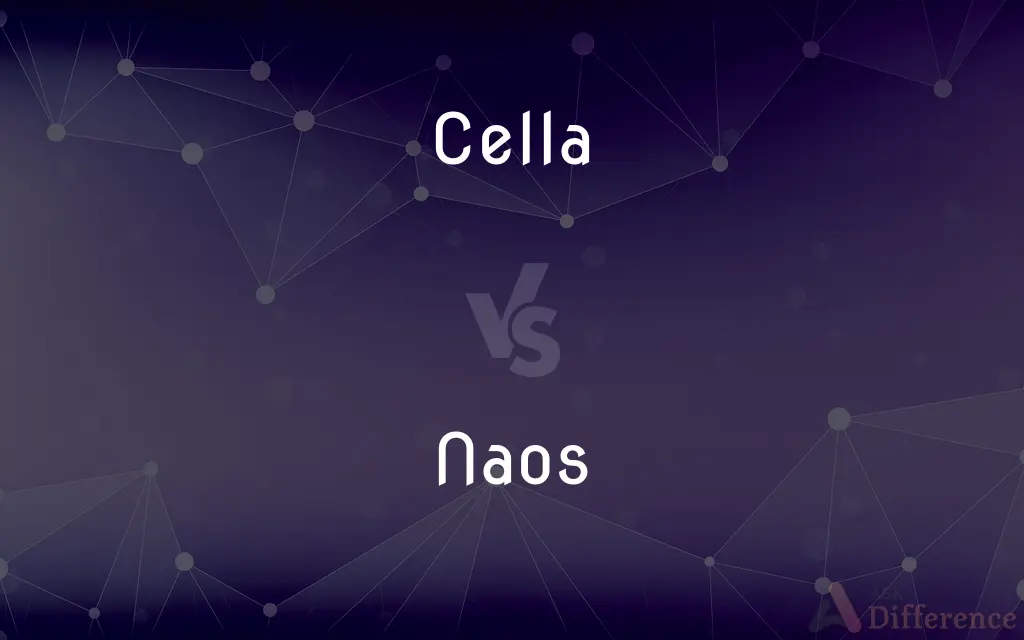Cella vs. Naos — What's the Difference?
By Maham Liaqat & Urooj Arif — Updated on April 26, 2024
Cella is the inner chamber of a classical temple housing the cult statue, while naos specifically refers to the central sanctuary within Greek temples.

Difference Between Cella and Naos
Table of Contents
ADVERTISEMENT
Key Differences
Cella is a term used in Roman architecture to describe the inner area of a temple that is usually enclosed and not accessible to the general public. This is where the statue of the god to whom the temple was dedicated is placed. On the other hand, naos refers more specifically to the principal chamber of a Greek temple where the cult statue is situated.
The cella is typically a single room or a complex of rooms in larger temples, serving as the most sacred area. Whereas, naos, as a part of the Greek architectural tradition, is essentially the Greek equivalent of the Roman cella but often emphasizes the enclosure aspect within the broader temple structure.
Architecturally, the cella may be completely enclosed by walls and accessible only through a single door, providing a secluded environment for the deity. In contrast, the naos, while also enclosed, often features a pronaos (a porch before the naos) which adds an additional architectural element to the Greek temples.
In terms of functionality, both the cella and naos serve the same primary purpose: to protect and house the deity's statue. However, the design and accessibility can differ, with some Greek temples' naos being partially visible to the public during certain rites, unlike the typically more secluded Roman cella.
The decoration and ornamentation of a cella can vary widely, often depending on the importance of the temple and the wealth of its patrons. Meanwhile, the naos, particularly in classical Greek architecture, might feature elaborate architectural designs like carved columns and detailed friezes to emphasize its significance.
ADVERTISEMENT
Comparison Chart
Cultural Context
Roman architecture
Greek architecture
Location in Temple
Inner chamber or core area of a temple
Central sanctuary of a temple
Function
Houses the cult statue, typically secluded
Houses the cult statue, central to religious rituals
Access
Generally restricted to priests or temple officials
More open, especially during ceremonies; may include a pronaos
Design
Simple or complex depending on the temple size
Often elaborate with architectural details
Compare with Definitions
Cella
A secluded room or set of rooms within a temple.
He studied the intricate carvings inside the cella of the ancient structure.
Naos
The sanctuary of a Greek temple containing the statue of the god or goddess.
Visitors could see the statue of Zeus through the open doors of the naos.
Cella
The inner area of a classical temple, housing the cult statue.
The cella of the Roman temple was only accessible to the high priests.
Naos
Often enclosed by columns and accessible via a pronaos.
The elaborate columns that framed the naos were iconic examples of Corinthian style.
Cella
Typically enclosed and not visible to the general public.
The treasures stored in the temple’s cella were discovered centuries later.
Naos
Serves as a focal point for religious ceremonies.
All eyes were on the naos during the offering ceremonies.
Cella
Contains the primary cult image or statue.
The cella held a magnificent statue of Athena, draped in gold.
Naos
Central chamber of the temple, essential for ritual practices.
The naos was specially prepared for the festival.
Cella
Central part of the temple, considered the most sacred.
During excavations, the cella was found to be remarkably well-preserved.
Naos
Architecturally significant, featuring detailed design elements.
The friezes around the naos depicted scenes from mythology.
Cella
A cella (from Latin for small chamber) or naos (from the Greek ναός, "temple") is the inner chamber of an ancient Greek or Roman temple in classical antiquity. Its enclosure within walls has given rise to extended meanings, of a hermit's or monk's cell, and since the 17th century, of a biological cell in plants or animals.
Naos
See cella.
Cella
The inner room or sanctuary of an ancient Greek or Roman temple, in which the statue of the god was situated.
Naos
The inner part of an ancient Greek temple, containing a statue of the temple's deity and surrounded by a colonnaded portico; (by extension) the Roman cella, which it later gave rise to.
Cella
In Byzantine architecture, the area of a centrally planned church in which the liturgy is performed.In both senses also callednaos.
Naos
A term used by modern archæologists instead of cella. See Cella.
Cella
(architecture) The central, enclosed part of an ancient temple, as distinguished from the open porticos.
Cella
The part inclosed within the walls of an ancient temple, as distinguished from the open porticoes.
Common Curiosities
How does the naos differ from the cella in terms of accessibility?
The naos may be more accessible to the public during religious ceremonies, unlike the typically restricted cella.
What is the primary function of the cella in Roman temples?
The primary function of the cella is to house the cult statue and serve as the most sacred area within Roman temples.
What architectural elements are commonly found in a naos?
The naos typically features architectural elements such as columns, detailed friezes, and sometimes a pronaos (front porch) that enhances its ceremonial prominence.
What is the significance of the cella’s location within a temple?
The cella is centrally located within the temple, underscoring its importance as the sacred space where the deity resides, making it the focal point of the temple's religious function.
Can the naos be seen by the public in Greek temples?
Yes, the naos could often be seen by the public during certain ceremonies or rituals when the temple doors were open.
Is the cella used in any other architectural styles besides Roman?
While the term "cella" is primarily associated with Roman architecture, it can also be applied in broader contexts to describe similar sacred chambers in other ancient architectural styles.
Can both the cella and naos be found in the same temple?
In terms of terminology, "cella" is typically used in Roman contexts and "naos" in Greek contexts. A temple would generally feature either term to describe its sacred chamber, depending on the cultural influence.
How do the contents of the cella and naos differ?
Both the cella and naos primarily contain the cult statue of the deity, but the cella may also house additional sacred objects or offerings, depending on the specific religious practices.
Are there architectural differences between the cella and naos?
Yes, the cella may be simpler or more complex, whereas the naos often features elaborate architectural details like columns and friezes.
How are the cella and naos protected or preserved in ancient temples?
Ancient temples often had specific architectural features and rituals designed to protect these sacred spaces, including gates, locks, and restricted access, along with regular maintenance and ritual cleansing.
What materials are used to construct a cella or naos?
The construction materials can vary, but they are often made from stone or marble, materials chosen for their durability and their ability to be intricately carved.
Do both the cella and naos have restricted access?
Typically, both have restricted access, but the naos might be more visible to the public during specific rituals or when the temple doors are open, unlike the cella, which is usually more secluded.
What role do the cella and naos play in religious ceremonies?
Both play central roles in religious ceremonies, with the deity’s statue being the focus for offerings and prayers. The ceremonies might differ slightly depending on cultural practices related to each architectural style.
Share Your Discovery

Previous Comparison
Sword vs. Sabre
Next Comparison
Align vs. CompareAuthor Spotlight
Written by
Maham LiaqatCo-written by
Urooj ArifUrooj is a skilled content writer at Ask Difference, known for her exceptional ability to simplify complex topics into engaging and informative content. With a passion for research and a flair for clear, concise writing, she consistently delivers articles that resonate with our diverse audience.















































